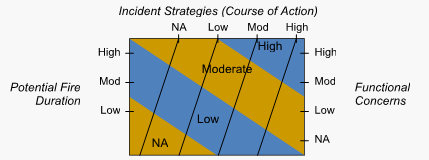Part 2: Implementation Difficulty
Figure 1: Implementation Difficulty Image

Implementation Difficulty Guidance
The Implementation Difficulty is a measure of how the specific circumstances that may be associated with a particular fire combine to represent potential intricate implementation concerns. While many specific situational elements have been addressed by the Relative Risk, special functional concerns and the requirement to implement the course of action selected to meet the incident objectives and requirements are addressed here. This assessment area also allows opportunity for the Agency Administrator to identify local information in regard to historic fire duration, special needs and concerns, and potential tactical responses. Implementation Difficulty addresses:
- potential fire duration,
- incident strategies (Course of Action), and
functional concerns.
Organization
Implementation Difficulty: Potential Fire Duration
Evaluate the estimated length of time that the fire may continue to burn if no action is taken and amount of season remaining. Rank this element low, moderate, or high. Note: This will vary by geographic area.
Implementation Difficulty: Incident Strategies (Course of Action)
Evaluate the level of firefighter and aviation exposure required to successfully meet the current strategy and implement the course of action. Rank this element as low, moderate, or high.
Considerations: Availability of resources; likelihood that those resources will be effective; exposure of firefighters; reliance on aircraft to accomplish objectives; trigger points clear and defined.
Organization
Implementation Difficulty:Functional Concerns
Evaluate the need to increase organizational structure to manage the incident adequately and safely, and rank this element N/A (current existing organization doesn’t have functional concerns), low (adequate), moderate (some additional support needed), or high (current capability inadequate).
Considerations: Incident management functions (logistics, finance, operations, information, planning, safety, and/or specialized personnel/equipment) are inadequate and needed; access to emergency medical services (EMS) support, heavy commitment of local resources to logistical support; ability of local businesses to sustain logistical support; substantial air operation which is not properly staffed; worked multiple operational periods without achieving initial objectives; incident personnel overextended mentally and/or physically; Incident Action Plans, briefings, etc. missing or poorly prepared; performance of firefighting resources affected by cumulative fatigue; and ineffective communications.
Recommended Organization
Type 5: Majority of items rated as N/A; a few items may be rated in other categories.
Type 4: Majority of items rated as Low, with some items rated as N/A, and a few items rated as Moderate or High.
Type 3: Majority of items rated as Moderate, with a few items rated in other categories.
Type 2/CIMT: Majority of items rated as Moderate, with a few items rated as High. Use Part D: Functional Complexity to document the need to increase or reduce capacity/positions.
Type 1/CIMT: Majority of items rated as High; a few items may be rated in other categories. Use Part D: Functional Complexity to document the need to increase or reduce capacity/positions.
Rationale:
Use this section to document the incident management organization for the fire. If the incident management organization is different than the Wildland Fire Risk and Complexity Assessment recommends, document why an alternative organization was selected. Use the Notes/Mitigation column to address mitigation actions for a specific element and include these mitigations in the rationale.